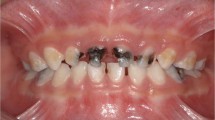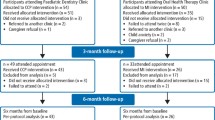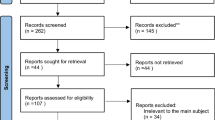Key Points
-
Examines the problem of early childhood caries and how it can be minimised.
-
Informs caries is a transmissible, infectious disease, which can be passed from mother to child.
-
Stresses the importance of risk assessment and preventive dentistry in paediatric healthcare.
Abstract
Recent increases in caries prevalence in young children throughout the world highlight the need for a simple but effective infant oral care programme. This programme needs to include a medical disease prevention management model with an early establishment of a dental home and a treatment approach based on individual patient risk. This article presents an updated approach with practical forms and tools based on the principles of caries management by risk assessment, CAMBRA. This method will aid the general practitioner to develop and maintain a comprehensive protocol adequate for infant and young children oral care visits. Perinatal oral health is vitally important in preventing early childhood caries (ECC) in young children. Providing dental treatment to expectant mothers and their young children in a 'dual parallel track' is an effective innovative strategy and an efficient practice builder. It promotes prevention rather than intervention, and this may be the best way to achieve long-lasting oral health for young patients. General dental practice can adopt easy protocols that will promote early preventive visits and anticipatory guidance/counselling rather than waiting for the need for restorative treatment.
Similar content being viewed by others
Log in or create a free account to read this content
Gain free access to this article, as well as selected content from this journal and more on nature.com
or
References
World Health Organization. Oral health country/area profile program (CAPP). Geneva: WHO, 2006. Online programme available at http://www.whocollab.od.mah.se/ (accessed October 2012).
Dye B A, Tan S, Smith V et al. Trends in oral health status: United States, 1988-1994 and 1999-2004. Vital Health Stat 11 2007: 1–92.
Pitts N B, Chestnutt I G, Evans D, White D, Chadwick B, Steele J G . The dentinal caries experience of children in the United Kingdom, 2003. Br Dent J 2006; 200: 313–320.
Al-Jewair T S, Leake J L . The prevalence and risks of early childhood caries (ECC) in Toronto, Canada. J Contemp Dent Pract 2010; 11: 1–8.
Armfield J M, Spencer A J . Changes in South Australian children's caries experience: is caries re-surfacing? Aust Dent J 2004; 49: 98–100.
Truin G J, van't Hof M A, Kalsbeek H, Frencken J E, König K G . Secular trends of caries prevalence in 6- and 12-year-old Dutch children. Community Dent Oral Epidemiol 1993; 21: 249–252.
Begzati A, Berisha M, Meqa K . Early childhood caries in preschool children of Kosovo – a serious public health problem. BMC Public Health 2010; 10: 788.
Ferro R, Besostri A, Meneghetti B et al. Oral Health inequalities in preschool children in North-Eastern Italy as reflected by caries prevalence. Eur J Paedr Dent 2007; 8: 13–18.
Vargas C M, Crall J J, Schneider D A . Sociodemographic distribution of pediatric dental caries: NHANES III, 1988–1994. J Am Dent Assoc 1998; 129: 1229–1238.
Li Y, Wang W . Predicting caries in permanent teeth from caries in primary teeth: an eight-year cohort study. J Dent Res 2002; 81: 561–566.
Alm A, Wendt L K, Koch G, Birkhed D . Prevalence of approximal caries in posterior teeth in 15-year-old Swedish teenagers in relation to their caries experience at 3 years of age. Caries Res 2007; 41: 392–398.
American Dental Association. Statement on early chidlhood caries. Chicago: ADA, 2007. ADA. Online statement available at http://www.ada.org/2057.aspx (accessed October 2012).
American Academy of Pediatric Dentistry reference manual 2010–2011. Pediatr Dent 2010–2011; 32: 1–334.
Hale K J, American Academy of Pediatrics Section on Pediatric Dentistry. Oral health risk assessment timing and establishment of the dental home. Pediatrics 2003; 111: 1113–1116.
American Association of Public Health Dentistry. First oral health assessment policy. AAPHD, 2004. Online policy available at http://www.aaphd.org/default.asp?page=FirstHealthPolicy.htm (accessed October 2012).
Academy of General Dentistry. Policies, guidelines, positions statements and fact sheets. Online information available at http://www.agd.org/issuesadvocacy/policies/dentalcare/ (accessed October 2012).
American Academy of Pediatric Dentistry. Definition of dental home. Chicago: AAPD, 2006 http://www.aapd.org/media/policies_guidelines/d_dentalhome.pdf (accessed October 2012).
Ismail A I, Nainar S M, Sohn W . Children's first dental visit: attitudes and practices of US pediatricians and family physicians. Pediatr Dent 2003; 25: 425–430.
Ramos-Gomez F, Ng M W . Six step protocol for a successful infant oral care visit. Pediatric dentistry today, 2009. http://www.cdhp.org/resource/six_step_protocol_successful_infant_oral_care_visit (accessed October 2012).
Ramos-Gomez F . Bacterial salivary markers' role in ECC risk assessment in infants. J Dent Res 2006; 85B: poster 0516.
Seki M, Yamashita Y, Shibata Y, Torigoe H, Tsuda H, Maeno M . Effect of mixed mutans streptococci colonization on caries development. Oral Microbiol Immunol 2006; 21: 47–52.
Douglass J M, Li Y, Tinanoff N . Association of mutans streptococci between caregivers and their children. Pediatr Dent 2008; 30: 375–387.
Tinanoff N, Kanellis M J, Vargas C M . Current understanding of the epidemiology mechanisms, and prevention of dental caries in preschool children. Pediatr Dent 2002; 24: 543–551.
California Dental Association Foundation, American College of Obstetricians and Gynecologists, District I X. Oral health during pregnancy and early childhood: evidence-based guidelines for health professionals. J Calif Dent Assoc 2010; 38: 391–403, 405–440.
Gajendra S, Kumar J V . Oral health and pregnancy: a review. N Y State Dent J 2004; 70: 40–44.
American Academy of Pediatric Dentistry, American Academy of Pediatrics, American Academy of Pediatric Dentistry Council on Clinical Affairs. Policy on early childhood caries (ECC): classifications, consequences, and preventive strategies. Pediatr Dent 2005–2006; 27: 31–33.
American Academy of Pediatric Dentistry, American Academy of Pediatrics. Policy on early childhood caries (ECC): classifications, consequences, and preventive strategies. Pediatr Dent 2008–2009; 30: 40–43.
Peretz B, Ram D, Azo E, Efrat Y . Preschool caries as an indicator of future caries: a longitudinal study. Pediatr Dent 2003; 25: 114–118.
Tagliaferro E P, Pereira A C, Meneghim Mde C, Ambrosano G M . Assessment of dental caries predictors in a seven-year longitudinal study. J Public Health Dent 2006; 66: 169–173.
Featherstone J D . The caries balance: contributing factors and early detection. J Calif Dent Assoc 2003; 31: 129–133.
Featherstone J D, Adair S M, Anderson M H et al. Caries management by risk assessment: consensus statement, April 2002. J Calif Dent Assoc 2003; 31: 257–269.
Featherstone J D . The caries balance: the basis for caries management by risk assessment. Oral Health Prev Dent 2004; 2: 259–264.
Featherstone J D . Caries prevention and reversal based on the caries balance. Pediatr Dent 2006; 28: 128–132.
Ramos- Gomez F J . Clinical considerations for an infant oral health care program. Compend Contin Educ Dent 2005; 26: 17–23.
Recommendations from MCHB Expert Panel. Topical fluoride recommendations for high-risk children – development of decision support matrix. Altarum Institute, Washington: 2007. Online article available at http://www.ncdhhs.gov/dph/oralhealth/library/includes/IMBresources/TopicalFluorideRpt%204-30-09%20edited%20with%20link%201-10.pdf (accessed October 2012).
American Dental Association Council on Scientific Affairs. Professionally applied topical fluoride: evidence-based clinical recommendations. J Dent Educ 2007; 71: 393–402.
Autio-Gold J . Recommendations for fluoride varnish use in caries management. Dent Today 2008; 27: 64–67.
Moberg Sköld U, Petersson L G, Lith A, Birkhed D . Effect of school-based fluoride varnish programmes on approximal caries in adolescents from different caries risk areas. Caries Res 2005; 39: 273–279.
Irigoyen M E, Luengas I, Zepeda M A, Sánchez-Pérez L T . Frequency of fluoride varnish application in prevention of dental caries. Xochimilco, Mexico: Universidad Autonoma Metropolitana.
Marinho V C, Higgins J P, Logan S, Sheiham A . Fluoride varnishes for preventing dental caries in children and adolescents. Cochrane Database Syst Rev 2002: CD002279.
Marinho V C, Higgins J P, Logan S, Sheiham A . Topical fluoride (toothpastes, mouthrinses, gels or varnishes) for preventing dental caries in children and adolescents. Cochrane Database Syst Rev 2003: CD002782.
Marinho V C, Higgins J P, Sheiham A, Logan S . One topical fluoride (toothpastes, or mouthrinses, or gels, or varnishes) versus another for preventing dental caries in children and adolescents. Cochrane Database Syst Rev 2004: CD002780.
American Academy of Pediatric Dentistry Clinical Affairs Committee, American Academy of Pediatric Dentistry Council on Clinical Affairs. Guideline on periodicity of examination, preventive dental services, anticipatory guidance/counseling, and oral treatment for infants, children, and adolescents. Pediatr Dent 2008; 30: 112–118.
American Academy of Pediatric Dentistry Clinical Affairs Committee, American Academy of Pediatric Dentistry Council on Clinical Affairs. Guideline on periodicity of examination, preventive dental services, anticipatory guidance, and oral treatment for children. Pediatr Dent 2005–2006; 27: 84–86.
American Academy of Pediatric Dentistry. Clinical guideline on periodicity of examination, preventive dental services, anticipatory guidance, and oral treatment for children. Pediatr Dent 2004; 26: 81–83.
Weinstein P, Harrison R, Benton T . Motivating parents to prevent caries in their young children: one-year findings. J Am Dent Assoc 2004; 135: 731–738.
Weinstein P . Provider versus patient-centered approaches to health promotion with parents of young children: what works/does not work and why. Pediatr Dent 2006; 28: 172–176.
Ramos-Gomez F J, Crall J, Gansky S A, Slayton R L, Featherstone J D . Caries risk assessment appropriate for the age 1 visit (infants and toddlers). J Calif Dent Assoc 2007; 35: 687–702.
American Academy on Pediatric Dentistry Clinical Affairs Committee- Restorative Dentistry Subcommittee, American Academy on Pediatric Dentistry. Council on Clinical Affairs Guideline on pediatric restorative dentistry. Pediatr Dent 2008–2009; 30: 163–169.
Acknowledgements
The authors would like to thank Claudie Damour-Terrasson, publishing director of the Groupe Information Dentaire, Paris France, for the authorisation of translation and publication of the series in the BDJ; Dr Norman Tinanoff, Dr Manwai Ng for contributing their support and knowledge to this project; Ms Debra Tom for her editorial assistance; and the HRSA Oral Health Disparities Collaborative for the implementation of the CAMBRA instrument and the development of the self-management goal instrument through High Plains Health Center. Finally, they wish to acknowledge the AAPD and AAP for their support and leadership on Caries Risk Assessment development.
Author information
Authors and Affiliations
Corresponding author
Rights and permissions
About this article
Cite this article
Ramos-Gomez, F., Crystal, Y., Domejean, S. et al. Minimal intervention dentistry: part 3. Paediatric dental care – prevention and management protocols using caries risk assessment for infants and young children. Br Dent J 213, 501–508 (2012). https://doi.org/10.1038/sj.bdj.2012.1040
Accepted:
Published:
Issue date:
DOI: https://doi.org/10.1038/sj.bdj.2012.1040
This article is cited by
-
Top tips for minimally invasive dentistry in primary care
British Dental Journal (2023)
-
Restorative thresholds for carious lesions in primary molars: French dentist’s decisions
European Archives of Paediatric Dentistry (2021)
-
Efficacy of P11-4 for the treatment of initial buccal caries: a randomized clinical trial
Scientific Reports (2020)
-
The effect of motivational interviewing on oral healthcare knowledge, attitudes and behaviour of parents and caregivers of preschool children: an exploratory cluster randomised controlled study
BMC Oral Health (2015)
-
Comparing potential early caries assessment methods for teledentistry
BMC Oral Health (2013)



